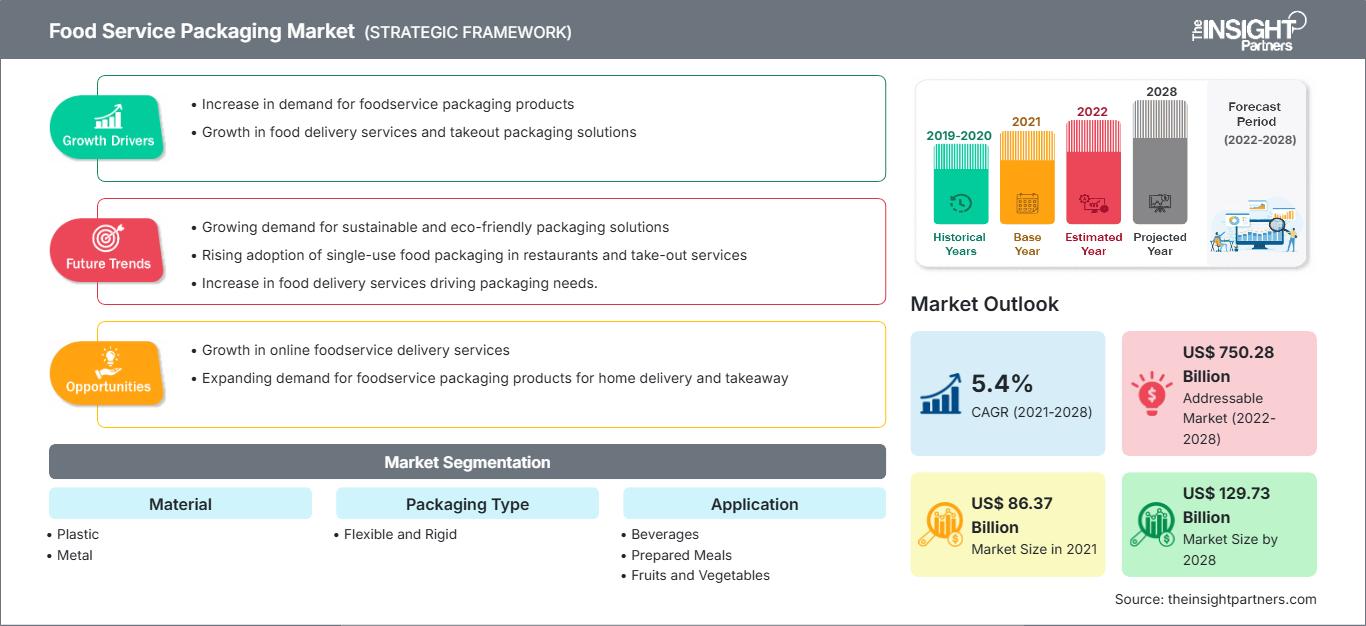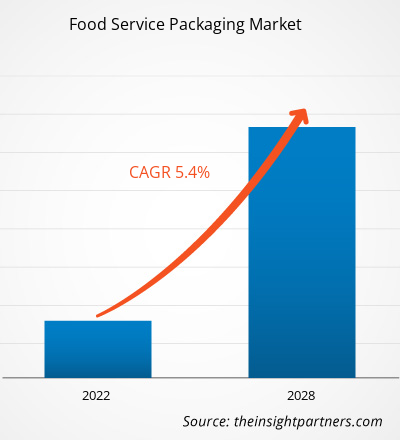[Forschungsbericht]Der Markt für Food-Service-Verpackungen wurde im Jahr 2021 auf 86.372,08 Millionen US-Dollar geschätzt und soll bis 2028 129.728,93 Millionen US-Dollar erreichen; es wird ein CAGR-Wachstum von 5,4 % zwischen 2021 und 2028 erwartet.
Food-Service-Verpackungen umfassen Produkte, die für das Servieren oder Verpacken von zubereiteten Speisen und Getränken in Restaurants, Imbissbuden und bei der Lieferung nach Hause verwendet werden. Zu den Food-Service-Verpackungsprodukten gehören Becher, Teller, Tabletts, Schüsseln, Beutel (für Einzelportionen und zum Mitnehmen), Behälter und Deckel, Besteck und Besteck, Eisbecher, Suppentassen und Getränketräger. Diese Produkte schützen die Lebensmittel vor Verunreinigungen durch Mikroorganismen, Luft und Feuchtigkeit.
Im Jahr 2020 hatte der asiatisch-pazifische Raum den größten Umsatzanteil am globalen Markt für Food-Service-Verpackungen. Die hohe Nachfrage nach Food-Service-Verpackungen in Restaurants, Cafés usw. treibt den Markt für Food-Service-Verpackungen im asiatisch-pazifischen Raum maßgeblich an. Online-Essensbestellungen nehmen in der Region aufgrund der Bequemlichkeit dieser Plattformen zu, was wiederum eine enorme Nachfrage nach verschiedenen Food-Service-Verpackungen schafft. China und Indien zählen zu den wichtigsten Märkten im asiatisch-pazifischen Raum. In Indien treibt der zunehmende Trend zum Außer-Haus-Essen unter der städtischen Bevölkerung das Marktwachstum des Landes an.
Passen Sie diesen Bericht Ihren Anforderungen an
Sie erhalten kostenlos Anpassungen an jedem Bericht, einschließlich Teilen dieses Berichts oder einer Analyse auf Länderebene, eines Excel-Datenpakets sowie tolle Angebote und Rabatte für Start-ups und Universitäten.
Markt für Foodservice-Verpackungen: Strategische Einblicke

- Holen Sie sich die wichtigsten Markttrends aus diesem Bericht.Dieses KOSTENLOSE Beispiel umfasst Datenanalysen, die von Markttrends bis hin zu Schätzungen und Prognosen reichen.
Auswirkungen der COVID-19-Pandemie auf den Markt für Food-Service-Verpackungen
Sie erhalten kostenlos Anpassungen an jedem Bericht, einschließlich Teilen dieses Berichts oder einer Analyse auf Länderebene, eines Excel-Datenpakets sowie tolle Angebote und Rabatte für Start-ups und Universitäten.
Markt für Foodservice-Verpackungen: Strategische Einblicke

- Holen Sie sich die wichtigsten Markttrends aus diesem Bericht.Dieses KOSTENLOSE Beispiel umfasst Datenanalysen, die von Markttrends bis hin zu Schätzungen und Prognosen reichen.
Die COVID-19-Pandemie beeinträchtigte Volkswirtschaften und Branchen in verschiedenen Ländern aufgrund von Lockdowns, Reiseverboten und Geschäftsschließungen. Im Jahr 2020 mussten verschiedene Branchen ihre Betriebsabläufe aufgrund von Störungen in den Wertschöpfungsketten aufgrund der Schließung nationaler und internationaler Grenzen drosseln. Die Pandemie störte die Produktionsprozesse aufgrund von Beschränkungen, die von Regierungsbehörden in verschiedenen Ländern verhängt wurden. Die schnelle Ausbreitung von COVID-19 stellte die Food-Service-Branche vor beispiellose Herausforderungen. Die Schließung von Restaurants, Bars und Clubs aufgrund von Social-Distancing-Maßnahmen in verschiedenen Ländern weltweit hat sich negativ auf die Nachfrage nach Food-Service-Verpackungen ausgewirkt.
Der zunehmende Verkauf von Essen zum Mitnehmen und Online-Bestellungen von Essen hat jedoch Chancen für Restaurants geschaffen. Die Wirtschaft begann 2021 wieder anzuziehen. Mit der Eröffnung von Restaurants, Bars, Clubs und anderen Gastronomiebetrieben steigt die Nachfrage nach verschiedenen Verpackungsprodukten für die Gastronomie weiter an.
Markteinblicke: Anstieg der Produktionskapazität von Verpackungsprodukten
Das steigende Interesse der Verbraucher am Verzehr frischer Produkte mit längerer Haltbarkeit und kontrollierter Qualität schafft eine Nachfrage nach Lebensmittelverpackungen. Dieser Faktor hilft Lebensmittelverpackungsherstellern, neue und sichere Verpackungen zu entwerfen und zu entwickeln. Darüber hinaus übt die wachsende Bevölkerung zusätzlichen Druck auf die Lebensmittelproduktionssektoren aus, verbesserte Lebensmittelverpackungslösungen einzuführen, um Lebensmittelverschwendung zu reduzieren. Daher zielt der aktuelle Ansatz zur Verbesserung der Lebensmittelindustrie darauf ab, Lebensmittelschäden und -verschwendung durch erhebliche Investitionen in die Entwicklung neuer und innovativer Technologien für Lebensmittelverpackungen zu verringern.
Materialeinblicke
Basierend auf dem Material wurde der globale Markt für Verpackungen für die Gastronomie in Kunststoff, Metall und andere segmentiert. Das Kunststoffsegment hatte 2020 den größten Anteil am globalen Markt für Verpackungen für die Gastronomie. Kunststoffverpackungen sind eine flexible Verpackungsform. Es ermöglicht Lebensmitteldienstleistern, Form, Stil und Größe der Verpackung an die Anforderungen ihrer Kunden anzupassen. Kunststoffverpackungen werden in der Lebensmittelindustrie bevorzugt, da sie leicht sind. Diese Vorteile von Kunststoffverpackungen haben Kunden aus der Lebensmittelindustrie angezogen. Daher erlebt der Markt für Kunststoffverpackungen für die Lebensmittelindustrie einen Aufschwung.
Anwendungseinblicke
Basierend auf der Anwendung wurde der globale Markt in Getränke, Fertiggerichte, Obst und Gemüse, Back- und Süßwaren, Milchprodukte und andere segmentiert
.
Das Segment Fertiggerichte hatte 2020 den größten Anteil am globalen Markt für Verpackungen für die Lebensmittelindustrie. Für die Verpackung von Fertiggerichten werden biobasierter und biologisch abbaubarer Kunststoff und Aluminium verwendet.Schalenversiegelung, Thermoformen, Standbeutel, Retortenverpackung & Es werden Beutel, selbsterhitzende Dosen und Stretchfolien verwendet, mit denen die Verpackungspräsentation der Lebensmittel individuell gestaltet werden kann.
Graphic Packaging International, LLC; Amcor PLC; Cambay Technopack Private Limited; Huhtamaki Global; AR Packaging; WestRock Company; Genpak, LLC; Vegware Ltd; BeGreen Packaging und Stora Enso gehören zu den Hauptakteuren auf dem globalen Markt für Lebensmittelverpackungen. Akteure auf dem globalen Markt für Lebensmittelverpackungen konzentrieren sich ständig auf Strategien wie Investitionen in Forschungs- und Entwicklungsaktivitäten, die Einführung neuer Produkte sowie Fusionen und Übernahmen. Marktteilnehmer konzentrieren sich auf die Bereitstellung qualitativ hochwertiger Produkte, um die Kundennachfrage zu erfüllen.
Berichts-Spotlights
- Fortschreitende Branchentrends im Markt für Food-Service-Verpackungen helfen den Akteuren bei der Entwicklung effektiver langfristiger Strategien
- Geschäftswachstumsstrategien in entwickelten und sich entwickelnden Märkten
- Quantitative Analyse des Marktes für Food-Service-Verpackungen von 2019 bis 2028
- Schätzung der weltweiten Nachfrage nach Food-Service-Verpackungen
- Porters Fünf-Kräfte-Analyse zur Veranschaulichung der Wirksamkeit von Käufern und Lieferanten in der Branche
- Jüngste Entwicklungen zum Verständnis des wettbewerbsorientierten Marktszenarios
- Markttrends und -aussichten sowie Faktoren, die das Wachstum des Marktes für Food-Service-Verpackungen vorantreiben und hemmen
- Unterstützung im Entscheidungsprozess durch Hervorhebung von Marktstrategien, die das kommerzielle Interesse untermauern und zum Marktwachstum führen
- Die Größe des Marktes für Food-Service-Verpackungen an verschiedenen Knotenpunkten
- Detaillierte Übersicht und Segmentierung des Marktes sowie als Dynamik der Food-Service-Verpackungsbranche
- Größe des Food-Service-Verpackungsmarktes in verschiedenen Regionen mit vielversprechenden Wachstumschancen
Food-Service-VerpackungRegionale Einblicke in den Markt für Lebensmittelverpackungen
Regionale Einblicke in den Markt für Lebensmittelverpackungen
Die Analysten von The Insight Partners haben die regionalen Trends und Faktoren, die den Markt für Food-Service-Verpackungen im Prognosezeitraum beeinflussen, ausführlich erläutert. In diesem Abschnitt werden auch die Marktsegmente und die geografische Lage von Food-Service-Verpackungen in Nordamerika, Europa, dem asiatisch-pazifischen Raum, dem Nahen Osten und Afrika sowie Süd- und Mittelamerika erörtert.
Umfang des Marktberichts zu Lebensmittelverpackungen
| Berichtsattribut | Einzelheiten |
|---|---|
| Marktgröße in 2021 | US$ 86.37 Billion |
| Marktgröße nach 2028 | US$ 129.73 Billion |
| Globale CAGR (2021 - 2028) | 5.4% |
| Historische Daten | 2019-2020 |
| Prognosezeitraum | 2022-2028 |
| Abgedeckte Segmente |
By Material
|
| Abgedeckte Regionen und Länder | Nordamerika
|
| Marktführer und wichtige Unternehmensprofile |
|
Dichte der Marktteilnehmer für Food-Service-Verpackungen: Verständnis ihrer Auswirkungen auf die Geschäftsdynamik
Der Markt für Food-Service-Verpackungen wächst rasant. Die steigende Nachfrage der Endverbraucher ist auf Faktoren wie veränderte Verbraucherpräferenzen, technologische Fortschritte und ein stärkeres Bewusstsein für die Produktvorteile zurückzuführen. Mit der steigenden Nachfrage erweitern Unternehmen ihr Angebot, entwickeln Innovationen, um den Bedürfnissen der Verbraucher gerecht zu werden, und nutzen neue Trends, was das Marktwachstum weiter ankurbelt.

- Holen Sie sich die Markt für Foodservice-Verpackungen Übersicht der wichtigsten Akteure
Globaler Markt für Foodservice-Verpackungen
Material
- Kunststoff
- Metall
- Sonstige
Verpackungsart
- Flexibel
- Starr
Anwendung
- Getränke
- Fertiggerichte
- Obst und Gemüse
- Backwaren und Süßwaren
- Milchprodukte
- Sonstige
Firmenprofile
- Graphic Packaging International, LLC
- Amcor PLC
- Cambay Technopack Private Limited
- Huhtamaki Global
- AR Packaging
- WestRock Company
- Genpak, LLC
- Vegware Ltd
- BeGreen Packaging
- Stora Enso
- Historische Analyse (2 Jahre), Basisjahr, Prognose (7 Jahre) mit CAGR
- PEST- und SWOT-Analyse
- Marktgröße Wert/Volumen – Global, Regional, Land
- Branchen- und Wettbewerbslandschaft
- Excel-Datensatz
Aktuelle Berichte
Verwandte Berichte
Erfahrungsberichte
Grund zum Kauf
- Fundierte Entscheidungsfindung
- Marktdynamik verstehen
- Wettbewerbsanalyse
- Kundeneinblicke
- Marktprognosen
- Risikominimierung
- Strategische Planung
- Investitionsbegründung
- Identifizierung neuer Märkte
- Verbesserung von Marketingstrategien
- Steigerung der Betriebseffizienz
- Anpassung an regulatorische Trends




















 Kostenlose Probe anfordern für - Markt für Foodservice-Verpackungen
Kostenlose Probe anfordern für - Markt für Foodservice-Verpackungen